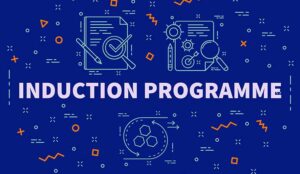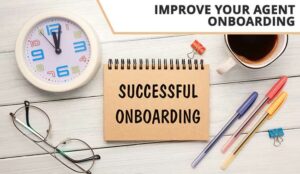Paul Pember, a customer service specialist, explains the difference between induction and onboarding and how companies can bridge the gap to successfully engage new starters and improve customer experience.
The terms ‘induction’ and ‘onboarding’ are often used interchangeably. However, these two terms mean different things and onboarding is more than just a new fancy name for induction.
This article will put this right by outlining how onboarding is not only different from induction it’s also a must-have in every contact centre, big or small.
This article will cover:
- What is the difference between induction and onboarding?
- Three benefits of having an onboarding programme
- Six features of effective onboarding programmes
- Six practical tips that you can implement today
What Is the Difference Between Induction and Onboarding?
Induction
Induction is typically defined as a new-starter’s first day or first few weeks within a new role. It tends to be focused on preparing the new starter with specific role-based information, such as processes, getting to know their colleagues, system training and service knowledge.
This may start with a one-day corporate induction, followed by a few structured days with their new team. The outcome of an induction tends to be that they reach full skill competency as quickly as possible to ensure they contribute to the resource needs of the contact centre.
The typical length of an induction is 1 to 7 days.
Onboarding
Onboarding is defined as the period of time from when the new starter accepts the job offer right up to passing probation and everything in between.
Like an induction, the outcome of onboarding is to ensure that the team member reaches the capability required.
In addition to this, onboarding is a more holistic and in-depth programme focused on developing a more rounded engaged and capable employee, someone who understands the ‘bigger picture’ by having a designed and curated learning programme that involves learning about the wider organization – history, context, plan and culture.
The typical length of an onboarding programme is 12 to 26 weeks.
3 Benefits of Having an Onboarding Programme
a. Increases Engagement
Engagement within a contact centre stems from new starters feeling confident, having a sense of belonging and being part of a team, supported by colleagues and their line manager, equipped with the knowledge and tools to do the role effectively and understanding how they contribute to organization success.
If all of these things aren’t designed in the first 6 months as part of the onboarding, then you’re heading for engagement issues. Papering over these key things with financial incentives or prizes just won’t cut it over the long term.
Therefore, rushing a new starter into taking customer contacts too quickly will only result in perceived short-term benefits. Engagement will start from a low point and will be difficult to recover from.
Plus, it can result in more performance issues taking up team leader time and will negatively impact your customer experience.
For tips and advice on how to improve your staff engagement, read our article: Staff Engagement: How to Motivate Employees – With a Checklist
b. Reduces Performance Issues
How many hours per week do you or your team leaders spend on performance issues? Do you or your team leaders end up spending most of your time ‘managing issues’ and not ‘leading people’?
Investing in a designed and curated onboarding programme and not rushing new starters into full capacity will increase productivity over time, and it will pay back handsomely. This is the number-one proactive way to reduce performance issues, rather than focusing on symptom management.
Try at all costs to avoid thinking about short-term performance targets and think about the medium- to long-term benefits of fully onboarded new starters.
Not only will an effective onboarding programme reduce performance issues, as a consequence of this it also results in a reduction of wasted team leader time managing performance problems, which means they have more capacity to focus on added-value proactive activities.
To find out more about how to improve the performance of call centre employees, read our article: 12 Great Tips to Improve Call Centre Performance
c. Improves Customer Experience
Making sure a new starter is fully equipped with the technical knowledge, soft skills, system knowledge, organization understanding and deep service/product knowledge will ensure high-tempo and high-quality customer interactions that ultimately result in getting the query resolved effectively.
This is due to a better understanding of how to control the conversation, as well as effective issue recognition and proactively understanding when further issues may occur and preventing them within the first conversation.
With digital advances over recent years, customers are calling because something has gone wrong, they couldn’t do it digitally or it’s a complex query.
Therefore, simply rushing new starters into answering calls in order to protect the call answer rate performance measure is not the solution for a customer experience-centred organization.
Our article 20 Customer Experience Management Tools and How They Can Help provides an oversight on other ways to improve your customer experience.
Six Key Features of an Effective Onboarding Programme
i. It Includes the Period Before the New Starter’s First Day
Why wait until their first day? Starting the onboarding from their first day is a missed opportunity. The most effective onboarding programmes maximize the time between the job offer and their first day.
An example of some activities to do before day one: a digital or printed welcome pack, introduction call with their line manager and a site visit to get a ‘feel’ for their new working environment.
This can be a low-cost and low-effort activity that will create a lasting impression and make the new starter feel at ease before they even start.
ii. It Includes Time Focusing on the Organization
It invests time on telling the ‘story’ of the organization, and the now – values, goals, current priorities and challenges – and also the ‘future’ – what are the goals and ambitions of your organization?
It’ll help them understand how they fit it and enhance their knowledge of the services and products of your organization.
iii. It Features a Mix of Blended Learning … and Is Engaging
To keep it fresh, energetic, interesting and support different learning styles. The best onboarding programmes cater for all and keep it fresh and dynamic, with lots of different learning sessions from virtual learning to practical to listening… to learning in a fun way.
Try not to tell, and do more engagement learning. This will stick way more.
iv. It Has the Potential to Be All or Partially Virtual
In this new world of ‘hybrid’ it’s going to be critical for organizations to have the capability to deliver onboarding fully or partially virtually.
This will require strong technology to support it, and you’ll need to be super-organized, as making it up day to day just won’t work virtually.
Virtual onboarding has the potential to be the most tedious and sleepy process – so it’s going to take some imagination to keep high energy levels and engagement throughout.
v. It Educates Them Practically on How to Be Successful in the Role
Many inductions hear about ‘day in the life’.
However, take this one step further by ensuring new starters hear from your high-performing advisors and anyone who has progressed within the contact centre or beyond.
Not only will this be inspiring and motivating, but it will help them practically to hear about the behaviours needed to be successful in your contact centre. It’s critical for new starters to hear, feel and smell what high performance looks like in their role.
vi. It Includes Performance Check-Ins During the Probation Period
It’s vital to set clear expectations of progress focused on both skills and behaviours that are expected at each stage of their onboarding programme. Don’t wait till the end of probation to flag performance concerns, this needs to be a fluid and regular dialogue.
Having ‘performance check-ins’ at regular stages throughout the probation will ensure a transparent dialogue to ensure both line manager and advisor are in step.
These conversations will help identify if further support is needed and how mitigations at this point can result in them passing their probation.
It’s worth just highlighting how important it is not just to focus on the knowledge but also on the behaviours they are showing – this is the team leader’s opportunity to uphold standards and prevent bad habits sneaking into your contact centre.
For more information on how to effectively discuss performance, read our article: 10 Good Feedback Examples to Improve Contact Centre Performance
Six Practical Tips You Can Implement Today
Even if you’re a smaller contact centre and only recruit one person at a time, the tips below apply to all sizes.
Tip 1 – Include Guest Speakers From Across Your Organization
This might be a director sharing their story and role and a chance to emphasize the importance of customer service and reinforce the organizational values, or a service/product expert who shares more in-depth knowledge about the service/product.
Or it might be someone from the customer insight team who can go through customer satisfaction and examples of where the organization has improved the customer experience, or someone who has progressed from the contact centre into the wider organization who can share their progression story.
Tip 2 – Send a Welcome Pack to New Starters Before They Join
The pack could include things like:
- welcome letter from the Contact Centre Director/Head
- welcome video from the team
- ‘get to know’ profiles of team members
- link to organization website
- job profile
- past team newsletters
- their first day/first week plan.
This will really help new starters settle in and feel at ease before their big first day.
Tip 3 – Use the Framework: ‘Global’, ‘National’ and ‘Local’
This framework helps structure onboarding programmes. The ‘Global’ part of the onboarding is focused on educating about the organization and sector. This tends to be the early stages of the programme. The ‘National’ part tends to then drill down to the service area/department.
This might introduce them to other teams within the service – data/insight/digital and other contact centre teams. The ‘Local’ drills down even more and focuses on the team and role the new starter is joining.
This helps split the activities into these three areas and keeps you focused on not just the ‘local’ part of the induction.
Tip 4 – Listen to a Selection of Customer Calls and Discuss Them
To aid engagement and deep learning, play a selection of calls and discuss them with the new starters. Just an open evaluative discussion around the call – this will get them thinking and not just being told what a great or bad call looks like.
This could then be complemented by getting them to use your quality assurance framework to assess the calls.
Tip 5 – Have Sessions Focused on Who Your Customers Are
Go through your customer personas, talk through your customer insight, discuss the features of your customer profiles – why do they use your product/service, why do they keep coming back to your organization? What drives both satisfaction and dissatisfaction when they contact you?
Tip 6 – Gain Feedback From Your Recent New Starters
Whether you’re looking to implement an onboarding programme or just want to improve your current one – then seek feedback from your recent new starters and team leaders. Through a focus group or/and a survey, ask your recent new starters for their evaluation of their first few months.
In addition, talk to your team leaders, who can feedback on which areas of the onboarding need to be strengthened. This will give insight into what’s working well now as well as improvement areas and gaps in your current induction/onboarding programme.
This will help the continual learning and improvement of the programme.
Many of these elements of onboarding aren’t expensive investments. They require time, effort and patience.

An effectively curated and designed onboarding programme can be the secret proactive ingredient in preventing future performance issues and improving customer experience, and it can be one of the key elements to support your contact centre reaching high performance.
Written by: Paul Pember
Author: Paul Pember
Reviewed by: Robyn Coppell
Published On: 4th Aug 2021 - Last modified: 6th Oct 2025
Read more about - Customer Service Strategy, Customer Service, Editor's Picks, Employee Engagement, Induction Training and Onboarding, Paul Pember, Service Strategy, Training and Coaching











































